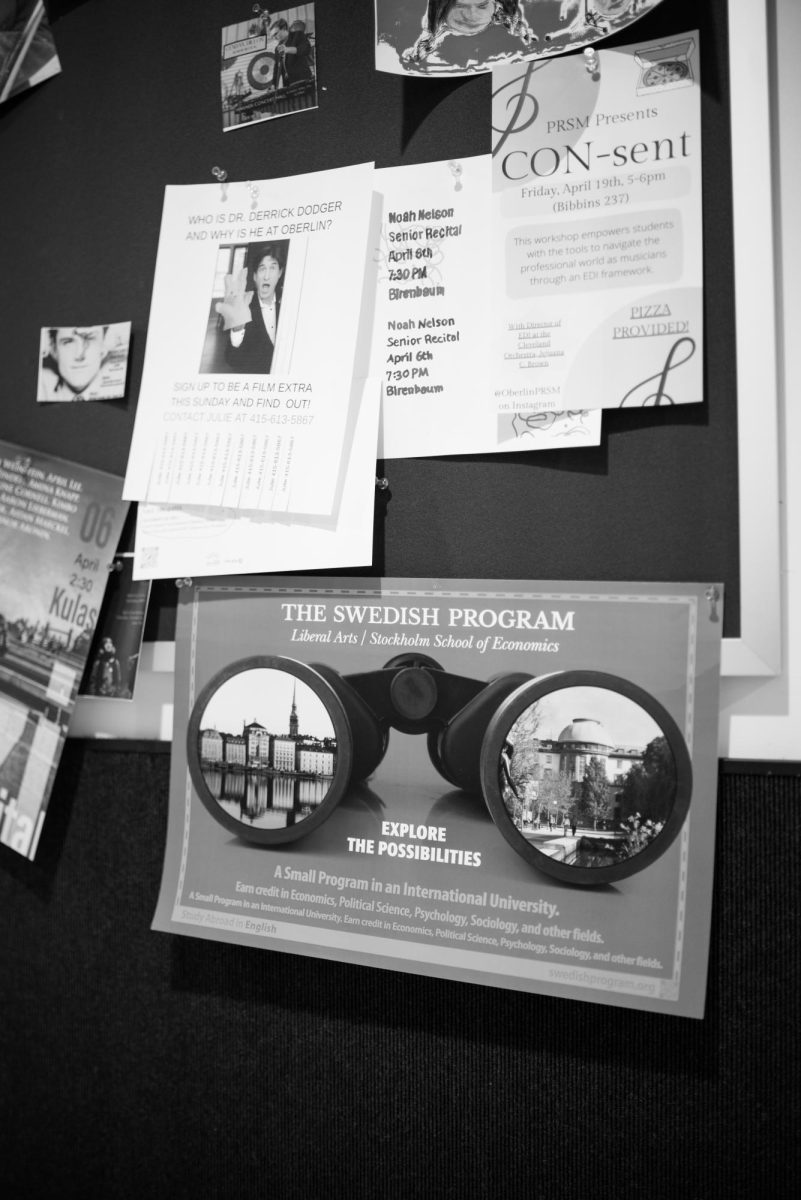Oberlin Students Perform Steve Reich’s Grammy Winning Piece at AMAM
March 9, 2012
Last Thursday, the Allen Memorial Art Museum hosted an evening of cross-genre minimalism as a part of its First Thursdays series. The event featured a performance of Steve Reich’s Grammy award-winning Different Trains and highlighted the AMAM’s impressive collection of minimalist sculpture.
Sarah Hamill, assistant professor of modern and contemporary art, began the evening with an introduction to the piece of music to be performed. She explained that the innovation and minimalism of Different Trains caused a shift in contemporary musical composition when Reich wrote the piece 20 years ago. Hamill described Reich’s inspiration for the piece, which included the time he spent as a child traveling on trains between his divorced parents’ homes in Los Angeles and New York. However, she explained that Different Trains is primarily a documentation of the Holocaust, depicting the trains that contributed to genocide by transporting millions to their deaths.
Hamill elucidated the connections between minimalist composition in music and visual art, explaining that sculpture was also being redefined around the same time that Different Trains made a splash on the contemporary music scene in 1988. In both media, repetition of notes or forms signals a minimalist approach that according to Hamill involves creating a meaning for the space, rather than having the focus on the object.
The space of the AMAM’s central gallery was transformed in preparation for the performance. Enormous bronze statues had been pushed to the outskirts of the room while art and music lovers settled into folding chairs, many more crowding around standing. With its high ceilings and reverential hush, the gallery normally presents itself as a kind of temple to art, but the ruckus of furniture created a different mood. The portraits hanging around the room, which usually seem so stately and formal, appeared to be bemused.
Chartreuse, a string quartet comprised of Conservatory sophomore Carrie Frey, Conservatory juniors Francesca Fetten and Helen Newby and double-degree senior Myra Hinrichs, performed Reich’s composition, demonstrating mastery of the piece and beautiful musicality. But the performance of Different Trains was multi-layered — there were recorded aspects to the piece along with the live performances by the musicians in the room. The music began with up-tempo, pre-recorded strings, which the musicians then joined, creating an excited mood with driving intensity.
The music rolled along steadily, evoking the turning wheels and shrill whistle of a train. At first, the tone was plaintive and somewhat disconcerting, created by the repetition of foreboding melodic lines and the harsh, grating sound of bows being scraped across strings. Although the musical lines were repeated multiple times and the tones of individual instruments blurred into a cloudy musical mass, gradual shifts in the music were audible. First, one of the repeated strains would change, and the rest would slowly join in. Then, suddenly, the whole piece had turned in a different direction with an almost imperceptible motion.
Recorded sounds added depth to the live music and worked particularly well as aural allusions to trains; some of these were literal, such as the sound of the occasional train whistle cutting through the instrumentation, while others were more distantly reminiscent. There was also a recorded vocal track which was barely audible over the scattered excitement of the music, evoking the feeling of being in a train station and straining to hear the announcements over the loudspeakers. The voice was repetitive, saying short phrases like “1941” and “Different trains.”
Perhaps halfway through the piece, the mood of the music became particularly stormy and frightening, and then it slowly faded away into silence. The next section, while still haunting, was much more gentle and mellifluous. The recorded voice repeated, “The war is over.” The piece ended abruptly but with a hopeful feeling, and the audience applauded with gusto, having been moved by the emotional impact of the work. The musicians beamed in recognition of the audience’s appreciation, smiling the whole time they exited the performance space.
Audience members then began to mill about the museum, which had extended hours after the performance. With the sound of minimalist music still ringing in their ears, the event’s attendees were able to appreciate the exquisite collection of minimalist sculpture with an enriched understanding of its cultural context — a truly Oberlin experience.


















